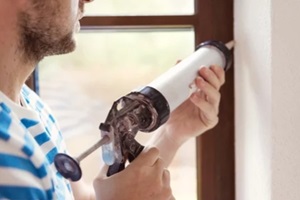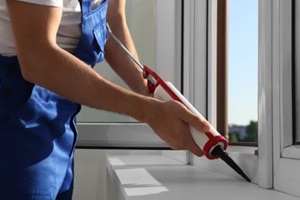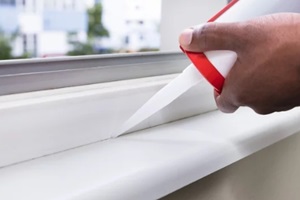 Exposure to harsh winter weather can leave homes susceptible to drafts, moisture intrusion, and higher energy bills. Professional caulking services provide a simple and effective solution to seal up joints and prevent cold air infiltration.
Exposure to harsh winter weather can leave homes susceptible to drafts, moisture intrusion, and higher energy bills. Professional caulking services provide a simple and effective solution to seal up joints and prevent cold air infiltration.
Proper caulking around windows, door frames, vents, and exterior cracks keeps the heat inside your home. However, low temperatures require special preparation and products to create long-lasting, durable seals.
With the proper techniques and materials, even frigid conditions won’t stop you from sealing out the cold.
Prepare Surfaces Properly for Maximum Adhesion
As with any remodeling job, proper planning and surface preparation is half the battle for effective cold-weather caulking. So, take the time to fully clean and dry all joints before applying any sealant material to give the caulk the best chance of adhering tightly.
For porous substrates, such as concrete, brick, and mortar, allow extra drying time after cleaning before priming or sealing. These materials continue to cure and release moisture long after installation, especially in cold weather.
Give them ample time to dry out to prevent adhesion failures down the road. A few dry, sunny days are ideal. Removing any moisture, frost, or ice from joints before caulking is also essential.
Even small amounts can lead to the sealant peeling or pulling away over time. If you encounter ice, use a hair dryer to gently thaw and warm the area before cleaning with a solvent. The extra heat opens up pores on the surface.
Once fully dry, you can apply a primer coat to boost adhesion if needed. Be sure to allow the primer to fully cure before moving on to the next step.
Choose Cold-Weather Sealants Built to Last
For top performance in frigid temperatures, avoid water-based latex caulks and opt for cold-weather formulas made from advanced silicones, polyurethanes, or hybrid polymers.
Although latex acrylics work fine for interior applications, they cannot properly cure when temperatures dip near or below freezing. The water in latex caulks freezes in cold temperatures, stopping the caulk from curing properly to form a tight seal.
 Look for sealants specially engineered to be applied and fully cure at temperatures as low as -20°F or beyond.
Look for sealants specially engineered to be applied and fully cure at temperatures as low as -20°F or beyond.
The packaging should indicate the recommended temperature range. These products remain flexible to accommodate the expansion and contraction of building materials through extreme cold spells.
Silicones offer excellent longevity and adhesion once cured. Polyurethanes stand up well to sunlight, moisture, and frequent movement. Hybrids, such as silylated urethanes, give you the best of both worlds with extreme durability and flexibility.
Apply Caulk for Airtight, Weatherproof Seals
Once you have your cold-weather sealant ready, it’s time to start applying it. But don’t let frosty conditions lead to a sloppy technique. Taking your time and following the following tips will ensure your caulk job stands the test of time.
First, only apply sealant when outdoor temperatures are above 40°F for the highest chance of success. Warmer days allow the caulk to fully cure and adhere properly.
If possible, aim to seal joints during peak daylight hours when the exterior substrate will be closest to the day’s high. This prevents expansion and contraction issues that can interfere while the caulk sets up.
Be sure to store the sealant tube or container in an indoor, room-temperature location before heading out to work. Don’t apply extremely cold caulk from the freezing truck bed or garage; it will be too thick to squeeze out smoothly.
If the caulk feels stiff, stand the tubes in warm water for about five minutes first to bring it up to a workable consistency that applies evenly.
With a properly loaded caulk gun, apply the sealant smoothly and evenly into joints using a constant motion at a 45-degree angle.
After filling the entire joint, use a plastic caulk tool to shape and smooth the caulk before a skin forms on the surface. This ensures full contact and adhesion from edge to edge.
Allow at least a few extra days beyond the recommended cure time listed by the manufacturer, especially as temperatures drop.
Also, protect freshly sealed areas from rain, snow, and freezing with a covered awning until fully set. When applied with care, high-quality, cold-weather caulks provide long-lasting protection from the elements.
Proper Sealing Saves Energy and Prevents Damage
 Preparing and using the right techniques for applying cold weather caulk ensures you seal out drafts, moisture, and pests in every season.
Preparing and using the right techniques for applying cold weather caulk ensures you seal out drafts, moisture, and pests in every season.
Proper sealing pays dividends in energy savings and prevents costly damage from water intrusion, mildew growth, and decay over time.
Get Expert Caulking Services in Philadelphia
For top results sealing out the cold, trust the expert caulking services of Waterproof Caulking & Restoration. With years of specialized experience assessing exterior damage and flaws, we provide customized caulking solutions to match your unique needs.
Contact us today at 484.265.9646 or schedule a consultation online to evaluate your home and start planning your cold-weather caulking services.
